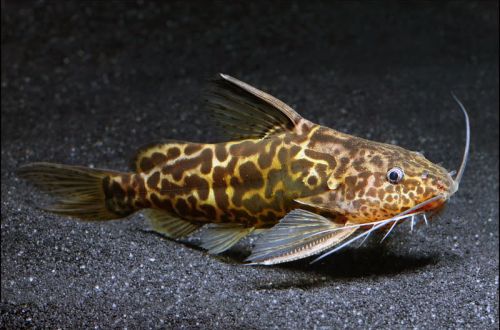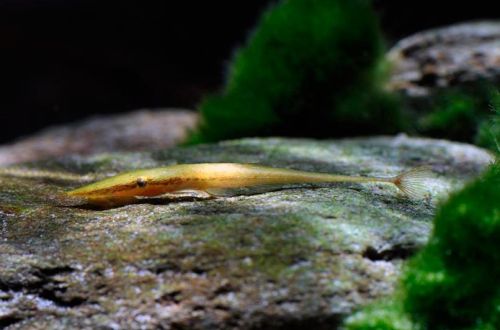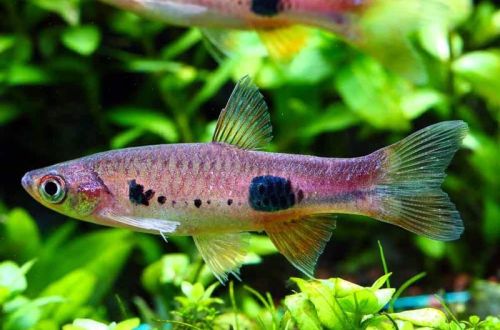
Synodontis marble
Synodontis marbled or Synodontis Shouteden, scientific name Synodontis schoutedeni, belongs to the Mochokidae family. A popular and unpretentious catfish, valued for its peaceful disposition and original body pattern. Compatible with most other popular aquarium fish. May be recommended for beginner aquarists.

Contents
Habitat
It comes from the limited basin of the Congo River in the territory of the modern Democratic Republic of the Congo. Occurs both in tributaries and in the mainstream, prefers areas with a soft substrate among rocks, snags and tree roots that form reliable shelters.
Brief information:
- The volume of the aquarium – from 80 liters.
- Temperature – 22-27°C
- Value pH — 6.0–7.5
- Water hardness – soft to medium hard (3-15 dGH)
- Substrate type – sandy
- Lighting – subdued or moderate
- Brackish water – no
- Water movement – light or moderate
- The size of the fish is 13–14 cm.
- Nutrition – any drowning
- Temperament – peaceful
- Keeping alone, apart from other relatives
Description
Adult individuals reach a length of about 13–14 cm. The body pattern consists of large dark spots of irregular shape on a yellow background, merging with each other in places. In general, the color is dark, chocolate color. The modified first rays of the pectoral and dorsal fin are sharp spikes for defense against predators. Sexual dimorphism is weakly expressed, it is problematic to distinguish a male from a female.
Food
Marble Synodontis is not picky about the diet, it will accept all types of popular dry sinking, frozen and live foods. It is recommended to include herbal supplements such as shelled peas, cucumber slice, or purchase dry kibbles that already contain herbal ingredients.
Maintenance and care, arrangement of the aquarium
The catfish is inactive and does not require a large space for swimming, so the optimal tank volume starts from 80 liters. The design uses a soft sandy substrate, various shelters that imitate the natural landscape (snags, branches, grottoes, caves) or decorative objects (wrecks, castles, etc.). Aquatic plants are welcome, but not mandatory, rather selected based on the needs of other aquarium neighbors. Prefers dim lighting, otherwise it will appear from cover mainly after the lights are turned off.
Water conditions have slightly acidic pH values with low or medium carbonate hardness (dH), the allowable temperature range is between 22–27°C.
Maintenance of the aquarium comes down to regular cleaning of the soil from organic waste, do not allow heavy pollution, silting, this can lead to infection of the catfish’s antennae. Maintaining a high quality of water is achieved by filtration and its weekly renewal (10–15% of the volume per) fresh.
Behavior and Compatibility
Peaceful and calm Marble Synodontis, perfectly combined with other fish of a similar and smaller size. It should not be kept together with aggressive and territorial species that can harm not only catfish, but also themselves.
Intraspecific relations are territorial in nature, each adult occupies a certain area and protects it from relatives, therefore, only one Synodontis should be contained in one aquarium, especially a small one.
Breeding / breeding
At the time of this writing, it was not possible to find reliable information about the successful breeding of this species in a home aquarium. Catfish for sale are supplied from commercial fish farms, where conditions typical of the natural habitat with its seasonality, as well as hormonal preparations, are recreated to stimulate spawning.
Fish diseases
The main cause of most diseases is unsuitable living conditions and poor-quality food. If the first symptoms are detected, you should check the water parameters and the presence of high concentrations of hazardous substances (ammonia, nitrites, nitrates, etc.), if necessary, bring the indicators back to normal and only then proceed with treatment. It has also been noted that Marble Synodontis can experience bloating when fed exclusively dry food, so be sure to include live or frozen food in the diet. Read more about symptoms and treatments in the Aquarium Fish Diseases section.





